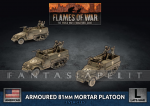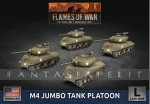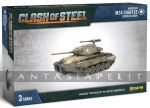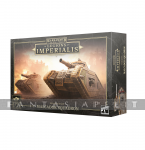includes three plastic M26 Pershing or T26 Super Pershing, one Decal Sheet and two Plastic Tank Commander Sprues.
The winter battles of late 1944 and early 1945 finally demonstrated to the US Army's high command that the M4 Sherman, though providing excellent service in previous years, was wholly inadequate to confront German heavy armour and anti-tank guns.
Furthermore, it fatally undermined the prevailing US tank doctrine, which had prescribed leaving the engagement of enemy tanks to the Tank Destroyer battalions, freeing the tanks to support the infantry and exploit gaps in the enemy lines. A new armoured vehicle was needed to better suited to the realities of modern warfare. Fortunately, after a good deal of political debate, the T26E3 heavy tank was put into production in November 1944.
The power plant was the same 500 horsepower Ford GAF V8 petrol engine in the latest versions of Sherman. The running gear had six double-bogies per side on a new torsion bar suspension running on a 23"/58cm wide track. Together, these improvements gave the T26 considerable speed for a tank in its weight class.
The final production model, the T26E3, was given the name Pershing, in honour of General John Pershing, commander of the American Expeditionary Force in the First World War. The Pershing provided US tankers with a vehicle that greatly improved on the M4 and was roughly comparable to the German Panther.
By the end of 1944, the first run of 40 T26E3s was complete and after a great clamour for them, the first batch of 20 arrived in the European Theatre of Operation (ETO) at the end of January 1945 as part of the Zebra Mission, a special mission to test the latest US designs of tanks and guns in combat conditions. These experimental T26s were therefore accompanied by a contingent of specialists to help report and iron out mechanical teething problems.
Ten T26E3 tanks were issued to each of the 3rd and 9th Armored Divisions. The 3rd Armored Division allocated five each to its 32nd and 33rd Armored Regiments, who in turn allocated a single example to their five tank companies.
Meanwhile, the 9th Armored Division allocated five of its T26s to the 14th Tank Battalion, which grouped them all into a single heavy tank platoon in A Company. The other five were given to the 19th Tank Battalion, which allocated one T26 to A Company and a pair each to B and C Companies.
The 3rd "Spearhead" Armored Division completed its training near the end of February and then put their T26s to the test on 25 February during the approach to the Rur River. The following night, near Elsdorf, F Company's T26, nicknamed "Fireball", was hit three times in an ambush by a "Tiger" and knocked out. The tank was repaired and back in action within a few days.
The Pershings had their revenge on 27 February, where 33rd Armored Regimentâ's T26 from E Company knocked out a "Tiger" at 900 yards using a special HVAP shell, followed by a standard AP shell. Shortly after, the Pershing also destroyed two Panzer IV tanks at the impressive range of 1200 yards.
On 6 March, Sergeant Bob Early's Pershing of E Company, 32nd Armored Regiment, was filmed flanking and destroying a troublesome Panther outside Cologne cathedral. Other 3rd Armored Division Pershings dispatched a Tiger and a Panzer IV near Cologne, and the T26 of D Company knocked out two further Tigers.
Two Pershings were lost approaching Cologne. One of these, belonging to H Company, 33rd Armored Regiment, was permanently written off after being knocked out by a German 8.8cm anti-tank shell from a tank-hunter firing just 200 yards away. After piercing the thick frontal armour, the round went through the forward compartments, between the driver's legs, and set off the ammunition on the floor of the tank. It was considerable good fortune that all the crew survived!
The Pershing's 90mm gun was powerful, but still lacked the ability to knock out the heavier German tanks, so an experimental gun was designed and designated the T15 90mm gun. Two examples of these massive guns were mounted in specially-modified Pershings, one of which made it into action with the 3rd Armored Division. This was further modified in the field by adding additional armour plates cut from destroyed German Panthers. The result was America's first and only super-heavy tank of the war.
The Super Pershing engaged the enemy, easily destroying German tanks that it encountered. Its most famous action was a duel with a German Königstiger at Dessau, which the Super Pershing bested after a short but fierce fight. The war ended before more Super Pershings could be built, but the design was considered successful enough to further develop the M26 series into a main battle tank.
The 9th "Phantom" Armored Division committed their Pershings in the final days of February during the fighting to cross the Roer River. One T26 from 14th Tank Battalion's heavy tank platoon was disabled on the night of 1 March when it was hit twice by a 150mm field gun. Like "Fireball", it was quickly repaired. The remaining four Pershings of the platoon, led by Lieutenant John Grimball, took part in the capture of the Ludendorff bridge at Remagen on 7 March. Concerns about the ability of the weakened bridge to carry the weight of the Pershings kept the platoon from crossing to the eastern side, so they provided support from the west bank.
In March 1945, the T26 was officially designated the M26 Pershing. A few more batches were deployed to Europe before the end of hostilities in May. A batch of 40 arrived at the port of Antwerp in late March and was issued to Ninth Army, which was then divided between the 2nd and 5th Armored Divisions. In April, 30 more were issued to the 11th Armored Division which became the last unit to get Pershings before the German surrender at the beginning of May 1945. By the end of the war, 310 Pershings had arrived in Europe with 200 issued to units.


































